Amphitheater of Opera Bastille, Opera National de Paris, is a middle-sized theater (a seating of 450) with modern equipment for lighting, sound system, etc.@
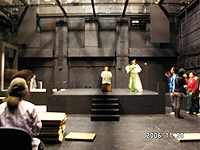 |
black-box theater in Taipei |
In 2006, gZhu Wen Elopes with the Ghost," a comical, classic play of a love story of ghost and man, which Taiwan's traditional opera theater company gGang- A-Tsui Theater," was performed at Taipei National Experimental Theater (black-box theater with a seating of 200). Four actors and seven musicians of period instrument participated in this play under my direction. In addition, for this play, I selected Ashikawa Yoko as a guest from our Butoh company.
What I, as a director, bear in mind before everything is drawing out enough the possibility of energy and emotion that each actor and musician's body possesses, and allowing those artists, who are living now, to play flexibly. This is also a basic attitude that I continue to advocate for my Butoh works. I consider a form as something dynamic that is continually generated, while it possesses an aesthetic absoluteness. So, a form rejects simply being applied to the cast.@@
Although Taiwanese traditional theater companies usually adopt classical design for clothes, hairstyle, and makeup, I, this time, completely changed the design to modern one to make full use of the character in the cast. For example, high shoe sole for female cast, a reminder of foot-binding, was changed to low one, for I felt that high one did not suit the body of performers who are also modern dancers.@@
About stage setting or stage design, I used an image from Noh stage, for I don't have the idea of stage equipment. I regard all of stage setting as stage design, that is, something directly related to one's individual way of life or matter of existence connected to the universal. To put it plainly, this is like a relationship between man and his or her house to live: you usually don't call your house equipment, or a cup you daily use prop. House or cup is closely connected to man's life, or is even charged with the history of human beings, so I regard them as art in that they are almost human.
That's why I don't have stage design exist independently; it must coexist with performers to invite poesy to the stage and demonstrate their character. Stage design, therefore, will naturally be influenced by each character of performers. My concept for stage design is self-effacingly simple, but I stick to texture and size with an accuracy down to units of millimeters. That's because I place importance on creating gnuke"---ga sensuous view sublated by letting the wind to antithesisses of oneself and others, life and death, good and evil, etc" (Tomoe Shizune)---in the theater space according to the various relationship with performers. gNuke" invites poetic emotion, making human communication possible in the profound and delicate sense. gNuke," in other words, can probably be compared with a poesy of Haiku that responses to surroundings, rather than with the scenario of a play.@ @
I bear in mind lighting plan in which the stage space seems to breathe. I don't use color filter for lighting, because colorful stage could easily make performers turn to a simple component of each scene. If the character of each performer is shown through on the stage, colors would naturally be produced there and be able to bring about more various contrasts and a natural depth to each scene. gZhu Wen Elopes with the Ghost" won Grand-prix of Taiwan Taishin Arts Award, which led to its public performance in Paris. The concept of my direction was almost the same as that of the performance in Taiwan, though the shape and texture of the theater was greatly different.@@
I was through amphitheater at Opera National de Lyon, France, in 1995. Wishing to create the relationship among all visitors, including audiences, to the theater, I induce the stage performance into a new one each time it is played, based on the intimate and delicate balance of elements of the theater. Accordingly, stage setting or stage design, positioning by performers, lighting, or choreography also greatly change each time. Such circumstances were the same as in the amphitheater in Lyon.
However, the Taiwanese performers had not been through the middle-sized hall of a seating of 450, to say nothing of Western-style amphitheater. They seemed to be very anxious about that.
This time, a wide space (ground stage) lies between the stage and audience seats. Also, the stage and the sound field is differently experienced visually or audibly, according to locations on the right or left side of the stage from audience's viewpoint.
How can we resolve this problem and share the feast on the stage together with the audiences? The following is also a directing method all my own: actors do adjustment of gawareness of body," which is, in the case of Butoh, inseparable from choreography.
If awareness of body and face is fixed, the presence of the performers will seem to increase because the fixation produces cutting-off from various elements on the stage, making their body and face seem to come up forward. This will invite a mere combination of body and scene or, even, of mutual scenes, ending up in depriving poetic emotion required for a live performance of the work. Furthermore, the characters of performers will excessively increase, and, though they certainly look more powerful, the beauty to invite poetic emotion, or gnuke", will be lost.(For further information about this, please see gFace of Butoh" in gJournal of Japanese Academy of Facial Studies, Vol. 9, 2009," a special article contributed by Tomoe Shizune & Hakutobo.)
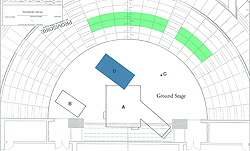 |
|
|
|
The plan is one of designs for the public performance at Amphi- theater of Opera Bastille, Opera National de Paris (For this play, I drew about 20 plans because of changes frequently requested by a Taiwanese producer. This plan is not final one.).
Area A is for a set up stage (height: 23 cm), area B is for musician seats (height: 4.5 cm), and area C is for an artwork (Actually, though the work I requested was in time for the deadline for the site, it didn't fit what I wanted. So, I cancelled it, and redrew the plan and changed lightning arrangement on the day before the acting).
Dance mats are laid on both the set up stage and ground stage. The height of the furthest audience seats from the stage is 240 cm.
In area B sit seven musicians. To say nothing of actors, musicians, too, were anxious about how to respond to the theater they had never experienced. I redrew a plan because some musicians in the cast were replaced and relocated.
My directing method vividly reacts to each character of all the performers and staff. Even if one of seven musicians was replaced, the new member's character would have influence on the entire content of the stage. If ignorant of this, directors would not even realize that mere form has preceded everything, which will cause the loss of live energy of various elements on the stage. And, if forcing the ignorance through, the work would almost be turned to a character doll performance displaying an excessively individual characteristic. The poetic emotion invited by gnuke" would slip through if you try to capture, and would be found formidably drifting in your surroundings with a sensation of full resignation. This sense is the most important element that represents Japanese culture.
I have musicians conscious of a virtual seat for them (Area D, which is 1.32 times larger than area B), saying, gPlease have an awareness that you were playing music in area D, not in area B where you are actually doing so.
This awareness of musicians would makes it possible that audiences sitting in green area would feel the sound directly. The location and size of area D were concluded after considering the relationship among characters and presence of the actors to perform on area A (set up stage) or the balance among aesthetic elements of the theater as a whole. Of course, using a different plan, I again gave actors the instruction about how to get awareness of body in this theater.
The performers immediately mastered the method, saying, gThe plan is very helpful to understand the method." To me, the experience meant both a joy and a menace.
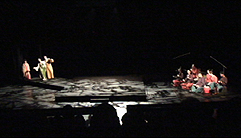 |
|
It is true that the public performance in Paris has resulted in success, but I became skeptical about how many artists of Japan, an unquestionably advanced country in the world of contemporary theater art, have had a flexible sense of body like Chinese or Taiwanese performers. I wondered if not a few artists here have forgotten the attractive characteristic of Orientals' body breathed by immersing themselves with the surroundings?
I thought that it was not strange in not so far future, Japan would be surpassed by Taiwan or China in the field of theater art.@
My attitude toward any people through art communication, though, will never change. It has been, and will be, the same since the beginning of my career...
In the collaboration performance of this time in Paris, where Butoh dance has now been recognized as popular art, I was afraid that a different critical paradigm could be applied to our company member (Ashikawa Yoko), and if so, she could even have an negative affect on the total recognition of the stage. It shouldn't by any chance happen that the participation of a Butoh dancer would bring disgrace on the reputation of Taiwanese excellent artists. As a director, I always have a source of anxiety. When making her appearance at a different theater in Paris, 1983, under the direction and choreography by Hijikata Tatsumi, Ashikawa received a slaughterably ruthless recognition, which resulted in breaking Hijikata's dream of overseas performance activity.
The reasons for the failure were clear: in addition to the fact that he was unfavorably compared with younger Butoh artists creating the spectacular stage popular in Paris at that time, Hijikata was so impatient to establish his Butoh dance style that the stage was full of faults in both the choreography and direction, which was only a concept-first, aggressive try.
Inheriting Hijikata Butoh after his death, I have examined his dance through practical activities, and learned everything about its limit on the earliest stage of my career. Thus I have established gTomoe Butoh Method" as a way to creative contemporary stage design based on expression of body.
Concerning the collaboration work of this time, I was much confident of my stage direction and choreography, including those for the Taiwanese performers.@@@ Originally, I think I have completely known both the talent and limit of our company members as we share a community life for 23 years.
However, it is also true that no one knows what may happen next at live performances made up of close-knit, invisible web of forces, so as in man's life of creative quality. Just in such a tense atmosphere grows up the true joy of stage design. I mean I can tell nothing until the end. But, if only we are not negligent about our life, we can believe that the muse or dance God gAmanouzume" will sometimes come and see us.@@@
Future about Collaboration Performance
Due to the matter of expenditure, 3-day studio practices were inserted using TV-telephone communication system connecting Taiwan with Tokyo.
 |
| Telepresence performance between Lyon and Tokyo |
We are well versed in the system, because we have already experienced more than 20 simultaneous live performances or lectures by connecting 2 remote places (for example, 2 stages in Tokyo and New York) using the system, individually constructed by us, since 1995. Thanks to the use of this system, in 2002, we had invitational public performances at Festival GRAME with musicians living in Lyon, France, at two theaters in Lyon and Tokyo.
It cannot be denied, though, that direction using this system needs much more time than on-the-spot direction, but, needless to say, artists' enthusiasm for creative stage can make up for the inconvenience caused by the distance. I think that the system has surely presented a new style of art communication in the age of globalism.
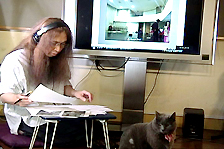 |
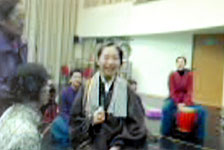 |
Tomoe Shizune work on direction(Tokyo) |
Actor of "Gang-A-Tsui Theater" (Taipei) |
|
|
Actor of "Gang-A-Tsui Theater" (Taipei) |
Musician of "Gang-A-Tsui Theater" (Taipei)
|
 |
|
A lesson using TV-telephone communication system connected between
Taipei and Tokyo, and Tomoe Shizune directing performers. |
